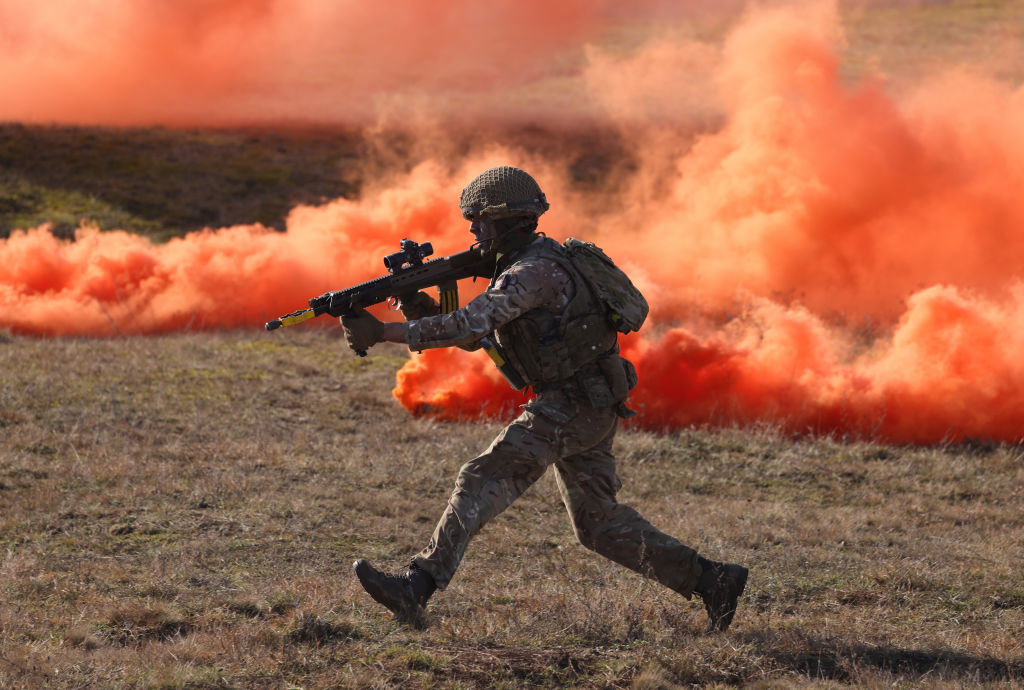Last week, the new head of the Army, General Sir Roly Walker, warned that war may be much closer than we think. Is our military ready? Two years ago, a syndicate of young officers published an article on the extreme shortage of division and brigade-level training in the British Army. Since then, the amount of larger-scale training has improved somewhat, despite a general resource shortage, but a form-filling safety regime has developed in our armed forces in the past decade which makes our army less combat ready.
It’s worth first understanding how safety works in the British Army. In recent years, several fatal accidents have been reported in its operations. Statistics are no comfort to a grieving family, but, since withdrawal from Afghanistan, the armed forces have become a significantly safer environment than the civilian world. Service personnel are 56 per cent less likely to die each year than their civilian peers.
The armed forces are subject to the same health and safety legislation as businesses (except where the Secretary of State explicitly waives it) but there cannot normally be criminal prosecutions when accidents occur. The military’s approach to safety is grounded in Lord Justice Haddon-Cave’s report on the 2006 Nimrod accident, which cost 14 lives.
Haddon-Cave laid down four principles of military safety: ‘strong leadership from the very top’, ‘independence throughout the regulatory regime’, ‘much greater focus on People in the delivery of high standards… not just on Process and Paper’ and keeping ‘regulatory structures, processes and rules as simple as possible so that everyone can understand them.’ Still, accidents continue to happen. For example, in 2021 a soldier was crushed to death sitting on the turret ring of a Scimitar reconnaissance vehicle, when its gun barrel struck a tree. More recently, a young officer was killed when a Warrior armoured fighting vehicle reversed over him.
Military accident reports tabulate long lists of shortcomings in process and a blizzard of recommendations on new processes, to improve safety. The latest Defence Land Safety and Environmental Regulations are 130 pages long, including pages of links to other documents. The old saying that an hour-long safety brief does not encourage a better safety culture seems apt.
Defence has also shifted the focus away from having clear lines of responsibility, surely the opposite of Haddon-Cave’s call for a move from process to people. For example, a designated staff officer in each brigade headquarters can, and regularly does, override commanding officers by forbidding the use of certain vehicles, based on centrally-held online records of the safety checks on those vehicles. Yet, unlike the commanding officer, that staff officer has no responsibility for, or involvement in, the vehicle checks that are logged in the system, on which his decisions are based.
This response to the dangers of military service is misjudged. The combination of more rules and less training over the past decade has led, many in the Army feel, to a loss of confidence, especially among vehicle operators, making them less competent and safe. A leading safety academic, Professor Sidney Dekker, combines study of safety across many industries with piloting airliners part-time, and has a specialist insight into those accidents where crews survived under especially challenging conditions (important in developing resilience for war).
He wrote in his book Safety Differently:
The conflictual adversarial model of safety regulation … leads to window dressing.’ Organisations should instead ‘monitor the gap between procedure and practice and try to understand why it exists [instead of just trying to close it by simply telling people to comply] … [as] informal work systems compensate for the organisation’s inability to provide the basic resources needed for task performance.
Too many officers working with old vehicles would recognise this description.
Training for war requires an approach which teaches people to assess, perform and take risks when tired, cold and frightened – circumstances where accidents are inevitably more likely. Severe as these issues are for regular soldiers, they make training for reserves, with much more limited time available, doubly hard.
Indeed, while the USA has part-time aviators flying F22 jets, our Army Reserve is having to downgrade from Jackal armoured reconnaissance vehicles to Land Rovers, because the Jackal’s safety regime has too many hoops for part-timers to jump through. It will be interesting to discover what lessons have been learned from the UK’s role in training Ukrainian recruits. We have trained them much faster than our own soldiers.
Faced with lawyers, media, and parliamentary attacks after accidents, senior officers and their political masters, understandably, want paper trails to cover backs in enquiries, coroners’ courts and civil action. But, reducing the stress and realism in training and cramping the authority of commanders – who should become the key to safety – has been the price.
The Ministry of Defence should set a different course. A lighter rulebook is needed. Legislation would help, but ministers and military leaders must explain publicly that preparing an army to fight a war involves accepting a degree of fatal risk, otherwise casualties will be much higher in war and our capability far lower. Today’s approach – safety by bureaucracy – has evolved in the expectation that war is many years away. In the light of Russia’s aggression, this assumption must change.







Comments